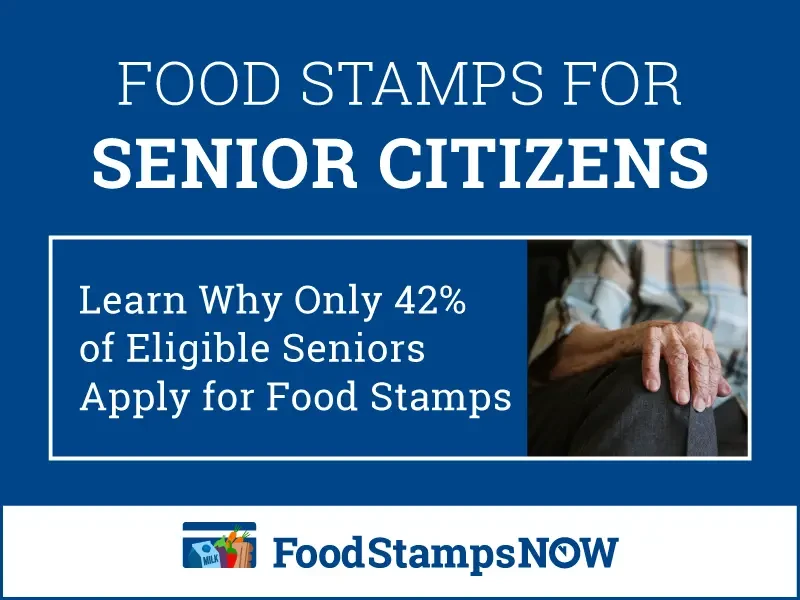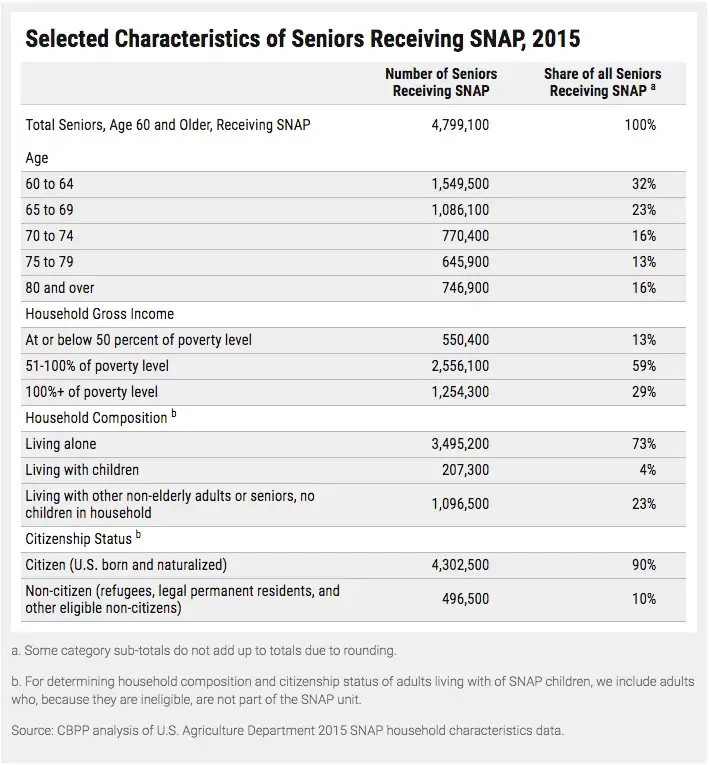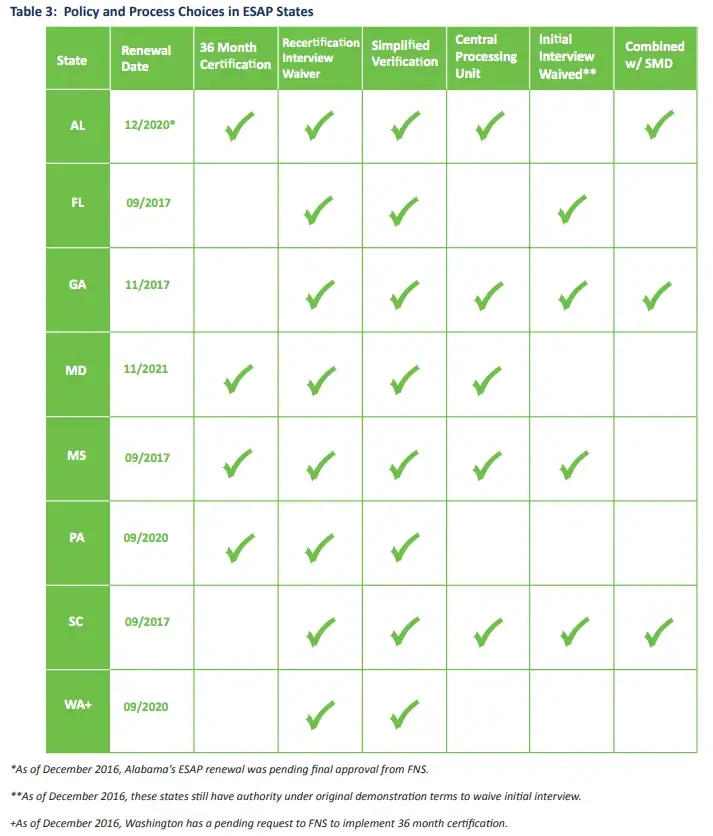Many seniors struggle with meeting their basic needs, including nutrition. One of the causes of this issue is the low participation of senior citizens in the food stamps program. In this article, we will examine the reasons why only 42% of eligible seniors participate in the food stamps program, versus 83% for the general population and what can be done to encourage eligible seniors to apply for food stamps.
America’s Growing Senior Population
The senior population in America continues to grow as the baby boomers reach retirement age. According to data from the National Council on Aging, in 2015, 48 million Americans were age 65 or older.
By 2030, that population will grow to 74 million, representing one in five Americans.
Growing Number of Seniors Living in Poverty
Unfortunately, as the population of seniors continues to grow rapidly, so is the number of seniors living in poverty, without enough food to eat.
According to data from the Kaiser Family Foundation, more than 7.2 million adults ages 65 and older lived in poverty in 2017 (14.1%) based on the Supplemental Poverty Measure.
The image below shows in detail this growing problem among seniors.
Food Insecurity Among Seniors
Among seniors age 60 and older, 5.7 million experienced food insecurity, resulting in poorer health and lower quality of life.
Food insecurity increases the likelihood of chronic disease, including high cholesterol, diabetes, and heart disease among older adults.
Chronic health conditions like high blood pressure and diabetes likely add to household expenses for seniors – and becomes an extra burden for those already experiencing food insecurity.
Ultimately, these health issues worsened by food insecurity become financially costly to the American society and taxpayers.
Benefits of Connecting Seniors with Resources
Studies show that connecting seniors with the resources to meet their basic needs will allow them to age in place with dignity while reducing healthcare costs.
In addition, there is new research that concludes that access to public benefits like Food Stamps reduces the likelihood of nursing home admission, hospital admission, and emergency department use among low-income seniors.
Boosting Food Stamps Participating Among Seniors
In 2015, there were 4.8 million seniors on food stamps (ages 60 and older), accounting for 10% of all Food Stamps recipients. However, that is only 42% of eligible seniors taking advantage of this important public benefit.
This means that there are 5.2 million seniors who were eligible for food stamps but are not participating. The table below from the Center on Budget and Policy Priorities provides more details:
Here are some of the reasons for the low participation in the Food Stamps program among seniors:
- Complex and cumbersome application processes
- Limited mobility
- Access to technology
- Lack of awareness about food stamps and who qualifies.
The image below, from the National Council on Aging (NCOA), paints a clearer picture of senior participation in the food stamps program by state.
To help increase senior participation in the food stamps program, the U.S. Department of Agriculture (USDA) has partnered states to test various strategies to improve the enrollment experience for eligible seniors.
What is ESAP?
The Elderly Simplified Application Project (ESAP) is a program launched between the USDA and select states to simplify the food stamps application experience for seniors.
This includes policy waivers and application processing improvements that, together, can improve access to food stamps for older adults.
The ESAP Changes States Can Make for seniors applying for food stamps include:
- Extending the certification period to 24 months from the current 6 or 12 month
- Waiving the full interview for recertification
- Waiving the requirement to verify unearned income, household size, residency, and shelter expenses, unless they are questionable.
The image below, from NCOA shows how various states participating in ESAP are trying to make the process easier on seniors to help boost participation rates.
How to Help Seniors Apply for Food Stamps
There several solutions available to help seniors apply for food stamps.
1. Increase ESAP Participation by States
The first solution for getting more eligible seniors to apply for food stamps is to get more states participating in the ESAP program.
This will help remove some of the barriers that have kept senior participation in the food stamps program so low.
Since states are responsible for administering the food stamps program, they have a greater responsibility to make the process less burdensome for seniors.
2. Involvement By Community Based Organization
Another effective solution to boosting senior participation in the food stamps program is to get more community-based organizations involved.
This is particularly true for organizations that are members of the aging or anti-hunger networks, or those involved in foods stamps outreach and enrollment, including:
- Community Agencies on Aging
- Aging and Disability Resource Centers
- State Health Insurance Assistance Programs (SHIPs)
- Ethnic Community Based organizations
- Anti-Hunger Community-Based Organizations
- Food Banks
- Faith-Based Organizations
- Senior Centers
3. Household Members
Part of the reasons some seniors are hesitant to apply for food stamps is the stigma associated with public assistance. Some seniors do feel ashamed to be seen as receiving welfare assistance.
Household members who live with seniors can be a source of encouragement to help end the stigma that deprives millions of seniors of much-needed nutrition assistance.
In addition, seniors need support in applying for benefits, including transportation and help to complete the paper or online applications.
Household members living with seniors can play an important role in helping seniors navigate the application process by helping them every step of the way.
Conclusion
There are steps that can be taken by states, community organizations and individuals living in senior households to help seniors get the nutrition assistance they need.
This is not only benefits seniors who are living in poverty but it also benefits society as a whole, in reducing healthcare cost.
If you have any questions about his article, or how to apply for food stamps, ask us in the comments section below.
If you are a senior citizen and want to learn more about how to apply for food stamps, click here.





